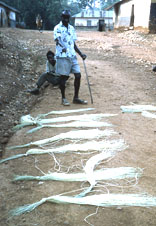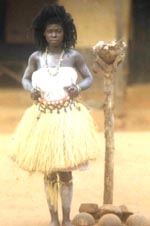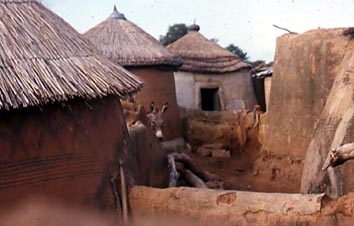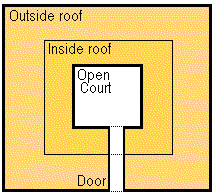Translations:
Other Pages:
CEC Training Modules
Akan Studies Site Map
Sociology for beginners
Contact
Kompan Adepa
Go to the People
Ghana Web
Round to Square;
Conversion from Guan to Akan
by Phil Bartle, PhD
Prior to the Akan expansion, the rainforest in what is now southern Ghana, was populated mainly by Guan settlements. They were neither a homogeneous group, nor were they unified into a single political system.
The Guan appear to have migrated from the north, likely because of the break up of the ancient Ghana empire.
The most influential Guan group today is Gonja, who are situated north and north-west of Asante, in the transitional areas where the rain forest borders the savannah. Another group, of interest for Kwawu history, are the Nchumuru, who are located north east of Kwawu. The Benkum (Left) division of Akwapem, led by Date (Larteh) retains its Guan language and patrilineal descent. Various coastal towns remain Guan, such as Simpa (Winneba) and others. The Nzima on the coast at the border between Ghana and Ivory Coast appears to be a blend of Guan and Akan. These are all extant remnants of the Guan.
The rest of the Guan populated areas which are now Akan.
When the Akan expanded, it was not all battle, conquer and kill. The Akan were more powerful militarily, and they used their reputation to negotiate expansion, resorting to war only if necessary. The local Guan population may have lost a few young men, but the Akan kept wives, children and gods as trophies.
On the Afram plains north of what is now Kwawu, on lowlands which have been flooded to a large extent by the formation of the Volta Lake by the dam at Akosombo, there was a Guan state, led by a series of chiefs called Ataara Firam (Fidam). The name of Afram and Firam is a derivative, as the river was a major contributory to the large river, Afrau (Aflao) which the Europeans renamed Volta.
When the Agona matriclan and its affines came to Kwawu, they conquered Ataara, and the people were converted to Akan. Importantly, this meant matrilineal descent, inheritance and succession.
In the oral history of the lineage of the Obo Ankobeahene (The “Does Not Go Anywhere Chief”), the elders of the time, who were Guan and patrilineal, saw that discretion was the best of valour, and decided to convert to matriliny. They took on the name of the matriclan, Aduana, the oldest of the matriclans, and swore allegiance to the first Akan state of the area, which was under Kumawu in what is now Asante. Most of that collection of matrilineages is now in the Nifa Division of Kwawu today.
In contrast to the Guan, the Akan appear to have come to the rainforest from the north as a result of the break up of the Mali Empire. They were opposed to Islam from its earliest contacts, and may have moved in response to Islamic expansion. That antipathy is documented in Islamic documents of the day, and contributes to a residual in that anyone taking office (chief, elder, priest) may not do so if circumcised.
What made the matrilineal Akan more powerful in war was not the matrilineal descent, succession and inheritance, directly, but the necessity for co-operation and confederation between matriclans in the Akan system. The Guan had separate patriclans in semi autonomous settlements. Women would move from their fathers’ patriclans to their husbands’ patriclans at marriage, which did not affect the overall social organisation. That cannot happen in matrilineal systems.
Matriliny is not the mirror image of patriliny. The reason is that women can move to their husbands’ lineage in patriliny, but cannot do that in matriliny. The women must retain their involvement in their matrilineage for the matrilineage to function and survive.
This, in turn, means that a settlement cannot have only one lineage, as it did with the patrilineal Guan. An Akan settlement had to have several matrilineages in it, so that women could marry, but retain their involvement in their lineage.
Akan settlements tend therefore to be composed of several lineages, and they needed some relationship between the lineages. In the Akan system, this meant confederations, where the lineages were seen as “married” to each other. A typical confederation, in turn, placed each lineage into a military position, paramount, vanguard, Rear Guard, Left Wing, Right Wing and Gyaase (something like a Ministry of the Interior).
At the same level of military technology and skills, the organised Akan had an advantage over the semi autonomous Guan patrilineages. In competition for control over trade routes through the rain forest, the Akan expanded and swallowed up most of the Guan. This expansion had important effects on Akan social organisation.
Women and children were not killed, and became the wives and children of the Akan. Even some young men were spared. Many Guan beliefs and practices therefore remained, and were merged with those the Akan brought.
One was that the local tutelary deities were retained. They were the personalities in the local rivers, mountains, and caves. Although each god could have several personalities, so younger ones were added, and they spoke Twi, most gods had older personalities that could not speak Twi, but spoke Guan. When the older Guan gods possessed their priests, their costumes often included a skirt made of oil palm branches made into bunched twine, and a belt made of cowry shells.
 |
 |
Making the Twine Finished Skirt
In the drum poetry of the Tano River, there is a phrase, “The stream crosses the path. The path crosses the stream. Which came first?” The answer is the river, so the Guan gods were there prior to the Akan ancestors.
Whereas the Guan often combined the office of priest with chief, there was a clear separation among the Akan. Chiefs were considered to be possessed by their own matrilineal ancestors, and priests were chosen by the gods. Everybody retained a patrilineal spirit line, based on those Guan origins, called ntrכ, which were based on the old Guan gods. See The Universe has Three Souls.
The six day week of the Guan was merged with the seven day week brought by the Akan, creating the 42 day cycle. See Forty Days.
Some observers see the Guan language as a variant of Akan language. There are many variations of Guan languages. It would make more logical sense to see Guan as composed of many variants, and Akan being one of them.
A few elements can be traced separately to the Akan and Guan origins. Among those most visible is the architecture.
Round to Square
Along with the conversion from patrilineal Guan to matrilineal Akan, houses changed from round to square.
An armchair anthropologist, on reading that, might argue that there is no intrinsic difference between round and square and that the difference lies only in the mind of the observer.
There is a branch of mathematics, topological maths, which may see round as square. It looks at the similarities of surface rather than shape. In it, a doughnut would be homologous to a lead pipe. But the architecture of the Guan and the Akan are distinctly different, and the people constructing them needed to use distinctly different construction techniques.
In the Guan architecture residential compound, the outside perimeter was a wall, and round houses inside the compound were separate structures. In the Akan architecture residential compound, the rooms were joined into a single building, its outside forming the periphery, and a small open air court enclosed in the middle. No wall or fence. One did not gradually grow into the other.
The separate round houses in the Guan compound had simple roofs with no corners. The Akan roofs had two types of corners: the four outside facing corners, and the four inside corners facing the inside courtyard. Two different kinds of construction techniques were needed to construct the two types of roof corners, neither of which were in the round houses.
The round houses in walled compounds can be seen in neighbouring Nchumuru. A few are left within Kwawu and are used as shrines of the ancient Guan gods. The square design is similar to architecture in Northern Africa, designed for the desert, not the rain forest. The square and the round designs clearly had different origins, the round ones found in traditional African south of the Sahara areas, and the square ones found in North Africa. See Akan Architecture.
 |
 |
 |
────> |  |